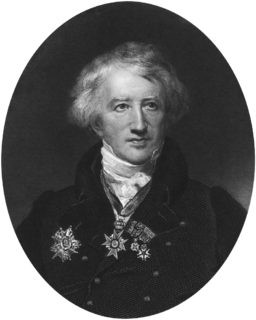
Jean Léopold Nicolas Frédéric, Baron Cuvier, known as Georges Cuvier, was a French naturalist and zoologist, sometimes referred to as the "founding father of paleontology". Cuvier was a major figure in natural sciences research in the early 19th century and was instrumental in establishing the fields of comparative anatomy and paleontology through his work in comparing living animals with fossils.

Bernard-Germain-Étienne de La Ville-sur-Illon, comte de Lacépède or La Cépède was a French naturalist and an active freemason. He is known for his contribution to the Comte de Buffon's great work, the Histoire Naturelle.
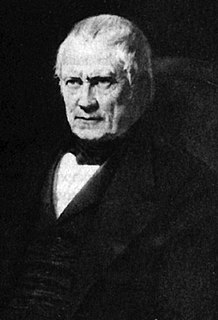
Henri Marie Ducrotay de Blainville was a French zoologist and anatomist.
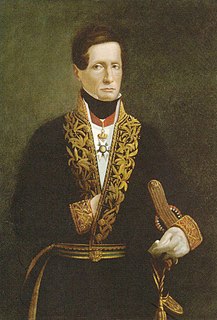
Jean René Constant Quoy was a French naval surgeon, zoologist and anatomist.

Alcide Charles Victor Marie Dessalines d'Orbigny was a French naturalist who made major contributions in many areas, including zoology, palaeontology, geology, archaeology and anthropology.
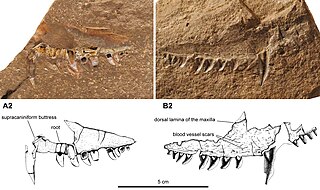
Neosaurus is an extinct genus of pelycosaur-grade synapsids from the Late Carboniferous-Early Permian of the Jura region of France. It is known only from a partial maxilla or upper jaw bone and an associated impression of the bone. The teardrop shape of the teeth in the jaw indicate that Neosaurus belongs to the family Sphenacodontidae, which includes the better-known Dimetrodon from the Southwestern United States. The maxilla was first attributed to an early diapsid reptile in 1857, and later a crocodylomorph in 1869, before finally being identified as a sphenacodont synapsid in 1899, a classification that still holds today.
Teleosaurus is an extinct genus of teleosaurid crocodyliform found in the Middle Jurassic Calcaire de Caen of France. It was approximately 3 metres (10 ft) in length. The holotype is MNHN AC 8746, a quarter of a skull. Other fragmentary specimens are known. A single species, T. cadomensis, exists. It was previously considered a wastebasket taxon, with many other remains assigned to the genus.
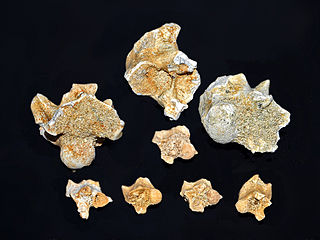
Palaeophis is an extinct genus of marine snake that is the type genus of the extinct snake family Palaeophiidae.

The rue Saint-Honoré is a street in the 1st arrondissement of Paris, France.

The Lesser Antillean macaw or Guadeloupe macaw is a hypothetical extinct species of macaw that is thought to have been endemic to the Lesser Antillean island region of Guadeloupe. In spite of the absence of conserved specimens, many details about the Lesser Antillean macaw are known from several contemporary accounts, and the bird is the subject of some illustrations. Austin Hobart Clark described the species on the basis of these accounts in 1905. Due to the lack of physical remains, and the possibility that sightings were of macaws from the South American mainland, doubts have been raised about the existence of this species. A phalanx bone from the island of Marie-Galante confirmed the existence of a similar-sized macaw inhabiting the region prior to the arrival of humans and was correlated with the Lesser Antillean macaw in 2015. Later that year, historical sources distinguishing between the red macaws of Guadeloupe and the scarlet macaw of the mainland were identified, further supporting its validity.
The Cheval du Morvan, also known as the Morvandiau, Morvandain or Morvandelle, is an extinct French horse breed from the Morvan massif in Burgundy, for which it is named. Horses were bred in the Morvan from before the French Revolution, both as saddle-horses for fox-hunting and as cavalry mounts, and for draught use. They were of small to medium height and known for their strength and tenacity. The Cheval du Morvan became extinct with the advent of industrialisation and improved transportation in the nineteenth century. As a draught horse it was replaced by the Nivernais and Comtois breeds, and as a saddle-horse by the Thoroughbred.
Centrochelys atlantica is an extinct species of tortoise that lived in the Pleistocene. It was first recorded in the volcanic crater on Sal, Cape Verde. It was initially identified as similar to the extant Testudo calcarata. The species is no longer present anywhere in the Cape Verde islands. It has since been described as a new species, differentiated from C. sulcata by its smaller size and lesser robusticity. It does not seem there is any evidence this species came into contact with humans.
Cyclocardia elegans is an extinct species of clam in the family Carditidae.
Elaeocyma drilliaeformis is an extinct species of sea snail, a marine gastropod mollusk in the family Drilliidae.
Elaeocyma subcostaria is an extinct species of sea snail, a marine gastropod mollusk in the family Drilliidae.
Crassispira subgranulosa is an extinct species of sea snail, a marine gastropod mollusc in the family Pseudomelatomidae, the turrids and allies. Fossils of this extinct marine species were found in Eocene strata of the Paris Basin, France.
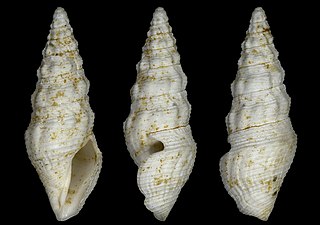
Crassispira margaritula is an extinct species of sea snail, a marine gastropod mollusc in the family Pseudomelatomidae, the turrids and allies. Fossils of this extinct marine species were found in Eocene strata of the Paris Basin, France.

Crassispira margaritula is an extinct species of sea snail, a marine gastropod mollusc in the family Pseudomelatomidae, the turrids and allies.

Pleurotomella fragilis is an extinct species of sea snail, a marine gastropod mollusk in the family Raphitomidae.
Kholumolumo, formerly "Kholumolumosaurus" or "Thotobolosaurus", is an extinct genus of massopodan sauropodomorph dinosaur, which was closely related to Sarahsaurus, from the lower Elliot Formation of Maphutseng, Lesotho. The type species, Kholumolumo ellenbergerorum was formally described in 2020.











